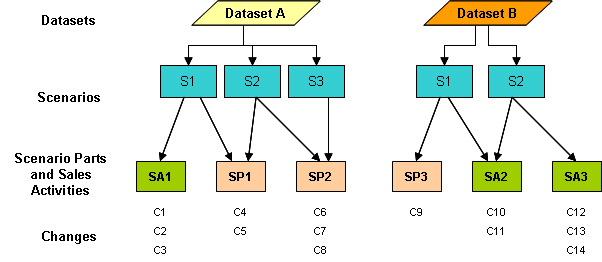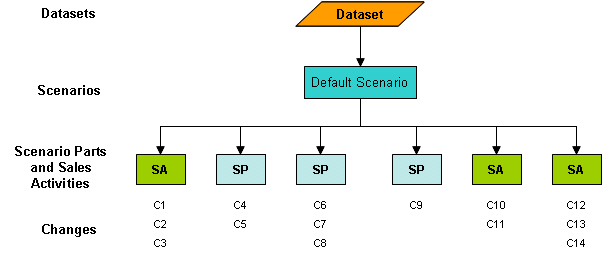Information Structure
This chapter explains how changes made to the values in a Dataset are organized in scenarios and scenario parts. This information structure enables the user to analyze the effects of changes and to choose the changes that must be included in a Sales Forecast Proposals.
Outcome
Changes are organized in scenarios and scenario parts. Each scenario part can be perceived as one layer of change information. A scenario is a selection of scenario parts.
Scenarios and scenario parts are used to analyze the effects of changes and to build and analyze alternative proposals. By viewing a Dataset with some scenarios, layers of change information (scenario part layers) are put on top of the basic data layer containing values. See Values and Changes.
Before Starting
- Knowledge of values and changes in M3 DMP must be acquired. See Values and Changes.
- Knowledge of the process flow and information flow in M3 DMP must be acquired. See Collaborative Demand Planning.
Purpose
The reasons for organizing changes in an information structure are:
- To enable the user to structure the changes and analyze the effects of the changes
- To enable the user to choose what changes to take effect.
Changes
A change is an increment (positive or negative) to a value. The changed value shown in the worksheet is the result of the calculation:
changed value = old value + increment
The information stored when a change is made is:
- The value that is changed (The unique set of key values identifying the value that has been changed.)
- The absolute increment (positive or negative).
Changes can be perceived as information that is put on top of the basic data layer containing the values. A change is always a member of one scenario part.
Scenario Parts
A scenario part can be seen as a layer of information containing some changes. One or more scenario part layers can be put on top of the basic data layer. The cells in a worksheet show the result of the basic data layer and the chosen scenario part layers. A cell displays a value from the basic data layer when the selected scenario parts contain no changes to the value in the cell (white cells). A changed value is displayed when the selected scenario parts do contain one or more changes to the value (green cells).
Scenario parts are the building blocks of scenarios. Each scenario part can be a member of more than one scenario that is linked to the same Dataset. A scenario part must always be a member of at least one scenario.
Scenarios
A scenario is a collection of scenario parts and can be perceived as a package of scenario part layers. When a scenario is displayed, the scenario part layers belonging to the scenario are put on top of the basic data layer.
A scenario is linked to a single M3 DMP Dataset. In general, a user can work with multiple scenarios for each Dataset. Scenario parts can only be members of different scenarios linked to the same Dataset.

Default scenario
Select "Automatic default Scenario per Dataset" in the Settings dialogue to disable the advanced features for managing scenarios. For each Dataset all scenario parts (and thus all changes) are linked to one default Scenario. When some view of the Dataset is displayed the default Scenario is always shown. That is, all scenario parts are put on top of the basic data layer by default, irrespective of the displayed view.

Confirm Change Scenarios
It can be chosen to Calculate and confirm change Scenario in the Change list. See Confirm Scenarios/Scenario Part. That is all changes belonging to all the scenario parts in the scenario are committed. See Values and Changes.